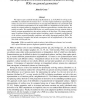39 search results - page 1 / 8 » Effects of Different Order PDEs on Blending Surfaces |
IEEECGIV
2006
IEEE
13 years 11 months ago
2006
IEEE
In this paper, we introduce second order and mixed order partial differential equations (PDEs) for surface blending and present an approximate algorithm for the resolution of the ...
IEEECGIV
2005
IEEE
13 years 10 months ago
2005
IEEE
We use two fourth order geometric partial differential equations to efficiently solve several surface modelling problems, including the surface blending, the N-sided hole fillin...
JSCIC
2006
13 years 5 months ago
2006
We improve upon a method introduced in (Bertalmio et. al. JCP 2001) for solving evolution PDEs on codimension-one surfaces in RN. As in the original method, by representing the su...
CAD
2010
Springer
13 years 5 months ago
2010
Springer
We present an approach to compute a smooth, interpolating skin of an ordered set of 3D balls. By construction, the skin is constrained to be C1 continuous, and for each ball, it i...
CVPR
2005
IEEE
14 years 7 months ago
2005
IEEE
In this paper we present coupled partial differential equations (PDEs) for the problem of joint segmentation and registration. The registration component of the method estimates a...

